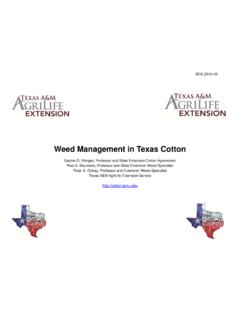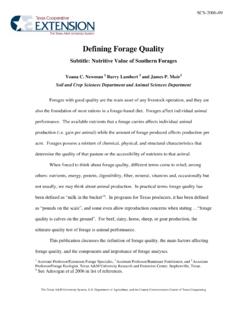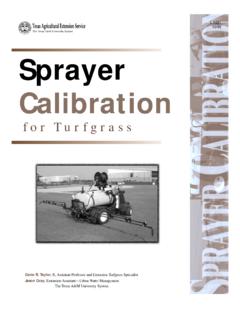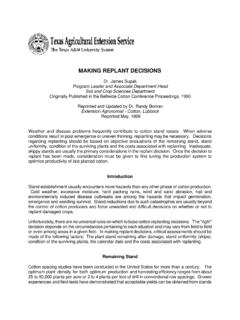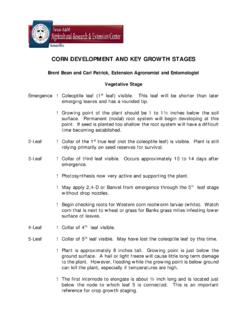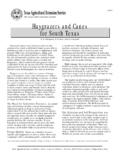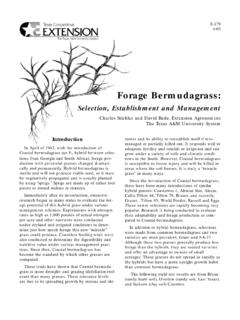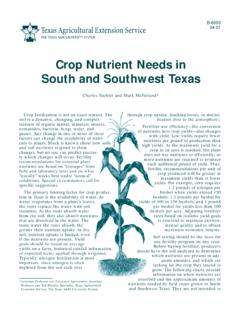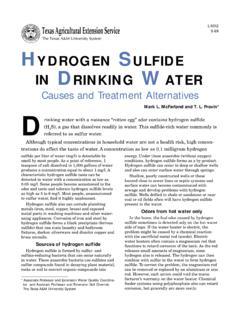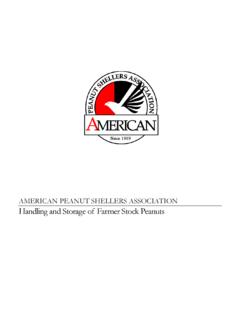Transcription of Production of Virginia Peanuts in the Rolling Plains and ...
1 Four market-types of Peanuts are grown in theUnited States Runner, Spanish, Virginia andValencia. Each type has different end-use qualitiesand manufacturer applications. Unlike other peanutproducing states, the soils, irrigation and climate inTexas are conducive for the Production of all fourmarket-types. Virginias have the largest kernels and account formost of the Peanuts roasted and eaten Peanuts are sold widely at sporting eventsand are known as ball park Peanuts . They are alsosold shelled as salted Peanuts . Thesepeanuts are primarily produced for the in-shell, export market. Traditional productionareas include Virginia and North Carolina,but Production in Texas has risen dramati-cally in the past 10 years because ofincreased contracting. In 1994,Texas growers harvested 27,300acres of Virginias in 21 counties,producing an average yield of about3,000 pounds per SelectionThe South Plains and Rolling Plains of Texas havethe soils and irrigation necessary to produce highquality Virginia Peanuts .
2 Light colored sands, loamysands and sandy loams with low clay content arebest. The large pods are more easily extracted fromloose, friable, sandy soils. In higher clay contentsoils, a large percentage of pods may be left in thesoil during the digging they areproduced for an in-shell market, hulls must bebright colored and free from stains and blemishesthat heavier soils might cause. Crop RotationCrop rotation is the key to profitable peanut produc-tion, especially with Virginias. They should beplanted in the same field only 1 year out of 3 or, inthe best case, 1 year out of 4. The advantages of croprotation are numerous; primarily they includeimproved soil fertility, reduced disease and nema-tode problems and more manageable weed controlsystems. In west Texas, cotton is the best alternative crop fora stable and profitable peanut rotation, althoughcorn, grain sorghum and small grains also are excel-lent peanut rotation crops.
3 The cotton/ peanut pro-duction system is the cornerstone for maintainingfuture peanut Production in theregion. Producers should avoid followingpeanuts with Peanuts , but wherethis has occurred, another cropalways should be planted thenext year and Peanuts should beleft out of the rotation for at least 3 to4 more years. Field research in theRolling Plains has shown that wherepeanuts are planted continuously, yieldsstabilize at about 2,500 pounds per acre;diseases such as pod rots, southern blight and scle-rotinia blight proliferate; and Production costsincrease. With proper rotations and good in-seasonmanagement, yields of 4,000 pounds per acre ormore are attainable. In the absence of rotation, Peanuts will not be a viable crop for the region. Soil Fertility and Plant NutritionPeanuts will not produce high yields when soil fer-tility is low, and they do not respond to direct fertil-ization.
4 A uniform, high fertility level must bedeveloped throughout the root zone. This is bestL-5140 Production of Virginia Peanuts in theRolling Plains and Southern High Plains of TexasRobert G. Lemon and Thomas A. Lee**Extension Agronomist and Extension Plant Pathologist,The Texas A&M University Agricultural Extension Service Zerle L. Carpenter, Director The Texas A&M University System College Station,Texasaccomplished by fertilizing previous crops. If a soiltest indicates the need for fertilizer, it is best toapply it before preparing the land. The primarytillage operations will distribute the fertilizerthroughout the root pHIn west Texas, low soil pH is seldom encountered;therefore, the use of agricultural lime is rarely, ifever, recommended. High pH soils ( and above)are normal for the region and can cause some nutri-tional deficiencies in Peanuts . Nitrogen, Phosphorus and PotassiumOne of the major benefits of producing Peanuts , orany legume, is that they require little nitrogen fertil-izer.
5 Peanuts have the ability to enter into a symbi-otic relationship with Rhizobiumbacteria theRhizobiumobtains its nutrition from the plant andthe plant gains usable nitrogen from the is known as the nitrogen fixation process. Withproper seed inoculation, the peanut plant requireslittle supplemental nitrogen fertilizer and directapplications of large amounts of nitrogen are gener-ally not recommended. Research in Gaines andHaskell counties from 1990 to 1993 did not indicateany yield or grade benefits from nitrogen fertiliza-tion at rates up to 200 pounds of nitrogen per , the higher the soil pH becomes, the lesseffective nitrogen fixation the most efficient use of phosphorus (phos-phate) and potassium (potash) fertilizers, applythem to the previous crop or before land prepara-tion, and thoroughly incorporate them into the rootzone. Always follow soil test recommendations toavoid over- or under-fertilizing the crop.
6 This isespecially important for potassium, because highlevels in the pegging zone have been found to inter-fere with calcium uptake and to increase the inci-dence of pod rotting organisms such as Pythiumand Rhizoctonia. If you have any questions aboutsoil testing, consult your county Extension agent-agriculture. CalciumIn Virginia peanut Production , calcium is by far themost critical nutrient for achieving high yields andgrades. Low levels of calcium cause several seriousproduction problems, including unfilled pods(pops), darkened plumules in the seed and poorgermination. In fields low in calcium and high insodium, a condition called pod rot is gypsum can must be available for both vegetative andpod development. Calcium moves upward in theplant in the xylem conducting tissues. It does notmove downward in the phloem. Therefore, calciumis not transported from leaves to pegs and to thedeveloping pods.
7 Pegs and pods absorb calciumdirectly from the soil, so it must be readily availablein the pegging zone. Foliar applied calcium treat-ments DO NOTcorrect calcium deficiencies. On high pH soils, calcium fertilization is accom-plished with agricultural gypsum (CaSO4). Calciumcontained in gypsum is relatively water soluble andcan be taken up by pegs and developing in Texas indicates that a soil test level of600 ppm calcium is adequate for Virginia peanutproduction. If soil calcium levels are less than 600ppm, or if irrigation water or soil is saline, gypsumapplications may be needed. Gypsum should not be applied during land prepa-ration or before planting because it can be leachedbelow the pegging zone. Best results have beenobtained when gypsum is applied at initial flower-ing (normally 30 to 40 days after emergence).Banded applications over the row (12- to 16-inchband) of 600 pounds of gypsum per acre, or broad-cast applications of 1,500 pounds of gypsum peracre, have proven to be adequate for Virginia pro-duction.
8 Rainfall or irrigation after application isneeded to move the gypsum into the pod develop-ment zone (upper 2 to 3 inches of soil). MicronutrientsMicronutrients include zinc, iron, manganese, cop-per, boron and molybdenum. Iron, zinc and copperdeficiencies have been observed in west chlorosis problems are most often observed onhigh pH soils and in fields that have high calciumcarbonate levels. Symptoms will be seen on theyoungest leaflets, which become pale green anddevelop an interveinal chlorosis. Iron chlorosis candevelop 1 to 2 weeks following , soil applications of iron fertilizer are inef-fective and costly. Instead, foliar spray treatments ofiron sulfate or similar materials should be madesoon after emergence if symptoms are may need to be repeated at 10-dayintervals if symptoms are deficiencies have been observed in theRolling Plains , and are often mistaken for otherproblems.
9 Initial symptoms include wilting of upperleaves, followed by chlorosis and leaf , brown tissue develops from the leaf marginsand progresses inward until the petiole can be significantly reduced. Soil applicationsof copper are the preferred method for managingdeficient fields. However, foliar spray treatments ofcopper sulfate or similar copper-containing materi-als applied at early-bloom correct problem fungicides containing copper also may correctthe availability is reduced when soil pH is symptoms include interveinal chlorosisof the youngest leaflets and, in severe situations,stunted plants and slow development of new and foliar applications of zinc fertilizers shouldcorrect problem fields; however, soil applicationsare and Water Use Irrigation is the key to current and future peanutproduction in west Texas. Irrigation ensures a stablesupply of high yielding, good quality, aflatoxin-freepeanuts.
10 The total seasonal water requirement formaximum peanut yields is approximately 20 to 28inches. This will vary from year to year based upontemperature, humidity and wind. In semiarid westTexas, high temperatures and low humidity coupledwith windy conditions contribute to high water con-sumption. The growing season for Peanuts can be divided intothree distinct phases pre-bloom/bloom, peg-ging/pod set and kernel fill/maturity. Water usevaries along with these developmental use is low in the early season, high during thereproductive period, and declines as pods begin stress during the bloom period can delay for-mation of flowers or, under extreme conditions,completely inhibit flowering. After bloom, peg pen-etration into the soil requires adequate active pegging and pod formation havebegun, the pegging zone should be kept moist withadditional water even if adequate moisture is pre-sent in the soil profile.

